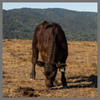-

Nov
10
Interpretive Summary: Clinical and microbiological effects in high-risk beef calves administered intranasal or parenteral modified-live virus vaccines

Our objective was to determine the safety, efficiency, and effects on immunity and nasal shedding of respiratory pathogens for high-risk cattle administered an intranasal (IN), trivalent (infectious bovine rhinotracheitis virus [IBRV], parainfluenza-3 virus [PI3V], and bovine respiratory syncytial virus [BRSV]) respiratory vaccine with parenteral, bivalent bovine viral diarrhea virus (BVDV), or a parenteral, pentavalent (BVDV type I and II, IBRV, BRSV, and PI3V) respiratory vaccine, compared to an unvaccinated negative control.
Read more
-

Nov
10
Interpretive Summary: A proof of principle study investigating the effects of supplemental concentrated brewer’s yeast on markers of gut permeability, inflammation, and fecal metabolites in healthy non-challenged adult sled dogs

This study evaluated the effects of concentrated brewer’s yeast on gut health in dogs. Nineteen Siberian Huskies and one Alaskan husky were blocked and randomly allocated to one of two groups. Treatment dogs received a yeast supplement for 10 wk, while control dogs received no supplement.
Read more
-

Nov
10
Interpretive Summary: Evaluation of fermented corn protein and its effects in either high or low branch chain amino acid to leucine ratio diets on nursery pig performance and feed intake preference

Three experiments were conducted to evaluate fermented corn protein (FCP) in nursery pig diets. Fermented corn protein is produced when protein and yeast fraction syrup from ethanol production is added back to high protein dried distillers grains to further increase CP and Lys content.
Read more
-

Nov
10
Interpretive Summary: MiR-18 inhibitor promotes the differentiation of bovine skeletal muscle-derived satellite cells by increasing MEF2D expression

Beef is a beneficial food source, and improving muscle yield and quality has become a hot topic in the beef industry. Therefore, our study aimed to explore effective methods to improve bovine muscle cell differentiation to increase beef production.
Read more
-

Nov
07
Thank you to the donors of the ASAS Foundation's Jim Corbin Appreciation Club

Having been awarded the Corbin Award in Companion Animal Biology is an honor. Dr. Corbin was a broad expert with diverse experience and the professional goal that I maintain for myself.
Read more
-

Nov
03
Interpretive Summary: Feeding dairy cows for improved metabolism and health
9aaf31897d8c62e581bfff00009094bd.png?sfvrsn=182353d1_0)
The objectives of this review are to 1) provide an overview of how inflammation is related to the metabolism and nutrition of dairy cows; 2) present some nutritional approaches that can be applied to modulate the immunometabolism of dairy cows; 3) point-out the state-of-the-art and the frontiers in knowledge regarding how these nutritional approaches interact with metabolism and immune system in dairy cows.
Read more
-

Nov
03
Interpretive Summary: Fescue toxicosis: a detrimental condition that requires a multiapproach solution
.png?sfvrsn=882253d1_0)
Tall fescue (Schedonorus arundinaceus (Schreb.) Dumort.) is a widely used cool-season forage among beef cattle, horses, and sheep farmers worldwide. The popularity of tall fescue relies on the superlative productive characteristics, such as biomass production and nutrient quality in different climatic and edaphic conditions.
Read more
-

Nov
03
Interpretive Summary: The impact of maturity stages on yield, quality, and nutritive value of ensiled Johnsongrass [Sorghum halepense (L.) Pers]
.png?sfvrsn=472153d1_0)
Johnsongrass [Sorghum halepense (L.) Pers.] is a perennial warm-season grass that was originally introduced to the United States as a forage in the 1830s in South Carolina. The objective of this study was to evaluate the effect of maturity stage at harvest on herbage accumulation, ensiling characteristics, and nutritive value of Johnsongrass.
Read more
-

Nov
03
Interpretive Summary: Digestible indispensable amino acid scores of animal and plant ingredients potentially used in dog diet formulation: how this protein quality metric is affected by ingredient characteristics and reference amino acid profile
.png?sfvrsn=1e2153d1_0)
Indispensable amino acids (IAA) are nutrients a dog requires, but that the dog cannot create naturally, so must be included in their diet. A concept known as protein quality (PQ) reflects how closely the IAA profile of an ingredient comes to meeting the dogs’ requirements.
Read more
-

Nov
03
Infographic: Digestible indispensable amino acid scores of animal and plant ingredients potentially used in dog diet formulation: How this protein quality metric is affected by ingredient characteristics and reference amino acid profile
.png?sfvrsn=72153d1_0)
This month’s infographic features (Templeman and Shoveller, 2022) an article examining how protein sources for canine diets are scored for protein quality. Protein ingredients vary in their ability to provide amino acids that dogs cannot create naturally (indispensable amino acids).
Read more
-

Nov
03
Infographic: Immunometabolism in Livestock
.png?sfvrsn=632153d1_0)
Inflammation is a key factor of many metabolic diseases (Davis, 2022). The field of immunometabolism is based on the interface of the immune system and metabolism, and seeks to better define the tissue-specific immunometabolic networks that coordinate adaptations to physiological challenges such as lactation or growth (Elsasser, 2022).
Read more
-

Oct
27
A new study finds Mexico’s ban on GM corn could have costly repercussions

A new report from World Perspectives Inc. details the possible impact of the potential Mexican restriction on genetically-modified (GM) corn. Consumer Price Impacts of Mexican Restrictions on GM Corn: An Economic Analysis, comes as Mexico’s government issued a decree, expressing a policy goal to gradually phase out glyphosate and GM corn use in the country by 2024.
Read more
-

Oct
27
Cultivating Revitalization by Expanding American Agricultural Trade and Exports Act of 2022 introduced
.png?sfvrsn=6e2a53d1_0)
A new bill titled the Cultivating Revitalization by Expanding American Agricultural Trade and Exports Act of 2022 (CREAATE Act) has been proposed to double funding for the United States Department of Agriculture’s (USDA’s) Market Access Program (MAP) and Foreign Market Development Program (FMD). The bipartisan bill was introduced by Senators Angus King (I-ME), Joni Ernst (R-IA), Tina Smith (D-MN), and Chuck Grassley (R-IA).
Read more
-

Oct
27
Executive order signed to advance biotechnology
.png?sfvrsn=812b53d1_0)
President Joe Biden recently signed an Executive Order Advancing Biotechnology and Biomanufacturing Innovation for a Sustainable, Safe, and Secure American Bioeconomy. The order directs United States Department of Agriculture (USDA) Agriculture Secretary Tom Vilsack and the USDA to submit a report assessing how to use biotechnology and biomanufacturing for cultured meat products.
Read more
-

Oct
27
FDA introduces new voluntary claims
.png?sfvrsn=c22b53d1_0)
The United States Food and Drug Administration (FDA) has issued a proposed rule to update the definition of the implied nutrient content claim “healthy”, which was originally set in 1994. The hope is that the updated "healthy" claim for food labeling will be consistent with current nutrition science and federal dietary guidance, specifically the Dietary Guidelines for Americans.
Read more
-

Oct
27
New Swine Inspection System upheld in court
.png?sfvrsn=dc2b53d1_0)
The United States Department of Agriculture’s (USDA’s) New Swine Inspection System (NSIS) was recently upheld in court. NSIS allows for additional inspection duties to be done by the processing facility’s employees as well as allows for faster line processing speeds.
Read more
-

Oct
27
Protect Farmers from the SEC Act Introduced
.png?sfvrsn=52b53d1_0)
The Protect Farmers from the SEC Act was recently introduced by Congressman Frank Lucas (R-OK), along with 80 other members of Congress. The bill would prohibit the U.S. Securities and Exchange Commission (SEC) from requiring an issuer of securities to disclose greenhouse gas emissions from upstream and downstream activities in the issuer’s value chain arising from farms and ranches.
Read more
-

Oct
27
USDA to give over half billion in pandemic relief to food workers
.png?sfvrsn=2a2b53d1_0)
The United States Department of Agriculture (USDA) has announced fifteen organizations that have been selected to receive funding from the Farm and Farm Workers Relief Grant Program (FFWR). USDA has set aside over $670 million in grants for the program.
Read more
-

Oct
27
White House announces plan to support fair and competitive meat and poultry markets
.png?sfvrsn=4d2b53d1_0)
During a meeting of the White House Competition Council, President Joe Biden introduced new efforts by the United States Department of Agriculture (USDA) to support fair and competitive meat and poultry markets. The Proposed Rule on Inclusive Competition and Market Integrity and Agricultural Competition Challenge to the State Attorneys General are said to protect livestock producers.
Read more
-

Oct
27
Takeaways of the White House Conference on Hunger, Nutrition, and Health
.png?sfvrsn=6c2b53d1_0)
At the end of September, the Biden Administration held the White House Conference on Hunger, Nutrition, and Health. The event ties into one of the administration’s goals to end hunger in America by 2030 through proposed legislation, regulatory changes, and public-private partnerships.
Read more
 NovInterpretive Summary: Clinical and microbiological effects in high-risk beef calves administered intranasal or parenteral modified-live virus vaccines
NovInterpretive Summary: Clinical and microbiological effects in high-risk beef calves administered intranasal or parenteral modified-live virus vaccines Our objective was to determine the safety, efficiency, and effects on immunity and nasal shedding of respiratory pathogens for high-risk cattle administered an intranasal (IN), trivalent (infectious bovine rhinotracheitis virus [IBRV], parainfluenza-3 virus [PI3V], and bovine respiratory syncytial virus [BRSV]) respiratory vaccine with parenteral, bivalent bovine viral diarrhea virus (BVDV), or a parenteral, pentavalent (BVDV type I and II, IBRV, BRSV, and PI3V) respiratory vaccine, compared to an unvaccinated negative control.
Our objective was to determine the safety, efficiency, and effects on immunity and nasal shedding of respiratory pathogens for high-risk cattle administered an intranasal (IN), trivalent (infectious bovine rhinotracheitis virus [IBRV], parainfluenza-3 virus [PI3V], and bovine respiratory syncytial virus [BRSV]) respiratory vaccine with parenteral, bivalent bovine viral diarrhea virus (BVDV), or a parenteral, pentavalent (BVDV type I and II, IBRV, BRSV, and PI3V) respiratory vaccine, compared to an unvaccinated negative control. NovInterpretive Summary: A proof of principle study investigating the effects of supplemental concentrated brewer’s yeast on markers of gut permeability, inflammation, and fecal metabolites in healthy non-challenged adult sled dogs
NovInterpretive Summary: A proof of principle study investigating the effects of supplemental concentrated brewer’s yeast on markers of gut permeability, inflammation, and fecal metabolites in healthy non-challenged adult sled dogs This study evaluated the effects of concentrated brewer’s yeast on gut health in dogs. Nineteen Siberian Huskies and one Alaskan husky were blocked and randomly allocated to one of two groups. Treatment dogs received a yeast supplement for 10 wk, while control dogs received no supplement.
This study evaluated the effects of concentrated brewer’s yeast on gut health in dogs. Nineteen Siberian Huskies and one Alaskan husky were blocked and randomly allocated to one of two groups. Treatment dogs received a yeast supplement for 10 wk, while control dogs received no supplement. NovInterpretive Summary: Evaluation of fermented corn protein and its effects in either high or low branch chain amino acid to leucine ratio diets on nursery pig performance and feed intake preference
NovInterpretive Summary: Evaluation of fermented corn protein and its effects in either high or low branch chain amino acid to leucine ratio diets on nursery pig performance and feed intake preference Three experiments were conducted to evaluate fermented corn protein (FCP) in nursery pig diets. Fermented corn protein is produced when protein and yeast fraction syrup from ethanol production is added back to high protein dried distillers grains to further increase CP and Lys content.
Three experiments were conducted to evaluate fermented corn protein (FCP) in nursery pig diets. Fermented corn protein is produced when protein and yeast fraction syrup from ethanol production is added back to high protein dried distillers grains to further increase CP and Lys content. NovInterpretive Summary: MiR-18 inhibitor promotes the differentiation of bovine skeletal muscle-derived satellite cells by increasing MEF2D expression
NovInterpretive Summary: MiR-18 inhibitor promotes the differentiation of bovine skeletal muscle-derived satellite cells by increasing MEF2D expression Beef is a beneficial food source, and improving muscle yield and quality has become a hot topic in the beef industry. Therefore, our study aimed to explore effective methods to improve bovine muscle cell differentiation to increase beef production.
Beef is a beneficial food source, and improving muscle yield and quality has become a hot topic in the beef industry. Therefore, our study aimed to explore effective methods to improve bovine muscle cell differentiation to increase beef production. NovThank you to the donors of the ASAS Foundation's Jim Corbin Appreciation Club
NovThank you to the donors of the ASAS Foundation's Jim Corbin Appreciation Club Having been awarded the Corbin Award in Companion Animal Biology is an honor. Dr. Corbin was a broad expert with diverse experience and the professional goal that I maintain for myself.
Having been awarded the Corbin Award in Companion Animal Biology is an honor. Dr. Corbin was a broad expert with diverse experience and the professional goal that I maintain for myself. NovInterpretive Summary: Feeding dairy cows for improved metabolism and health
NovInterpretive Summary: Feeding dairy cows for improved metabolism and health9aaf31897d8c62e581bfff00009094bd.png?sfvrsn=182353d1_0) The objectives of this review are to 1) provide an overview of how inflammation is related to the metabolism and nutrition of dairy cows; 2) present some nutritional approaches that can be applied to modulate the immunometabolism of dairy cows; 3) point-out the state-of-the-art and the frontiers in knowledge regarding how these nutritional approaches interact with metabolism and immune system in dairy cows.
The objectives of this review are to 1) provide an overview of how inflammation is related to the metabolism and nutrition of dairy cows; 2) present some nutritional approaches that can be applied to modulate the immunometabolism of dairy cows; 3) point-out the state-of-the-art and the frontiers in knowledge regarding how these nutritional approaches interact with metabolism and immune system in dairy cows. NovInterpretive Summary: Fescue toxicosis: a detrimental condition that requires a multiapproach solution
NovInterpretive Summary: Fescue toxicosis: a detrimental condition that requires a multiapproach solution.png?sfvrsn=882253d1_0) Tall fescue (Schedonorus arundinaceus (Schreb.) Dumort.) is a widely used cool-season forage among beef cattle, horses, and sheep farmers worldwide. The popularity of tall fescue relies on the superlative productive characteristics, such as biomass production and nutrient quality in different climatic and edaphic conditions.
Tall fescue (Schedonorus arundinaceus (Schreb.) Dumort.) is a widely used cool-season forage among beef cattle, horses, and sheep farmers worldwide. The popularity of tall fescue relies on the superlative productive characteristics, such as biomass production and nutrient quality in different climatic and edaphic conditions. NovInterpretive Summary: The impact of maturity stages on yield, quality, and nutritive value of ensiled Johnsongrass [Sorghum halepense (L.) Pers]
NovInterpretive Summary: The impact of maturity stages on yield, quality, and nutritive value of ensiled Johnsongrass [Sorghum halepense (L.) Pers].png?sfvrsn=472153d1_0) Johnsongrass [Sorghum halepense (L.) Pers.] is a perennial warm-season grass that was originally introduced to the United States as a forage in the 1830s in South Carolina. The objective of this study was to evaluate the effect of maturity stage at harvest on herbage accumulation, ensiling characteristics, and nutritive value of Johnsongrass.
Johnsongrass [Sorghum halepense (L.) Pers.] is a perennial warm-season grass that was originally introduced to the United States as a forage in the 1830s in South Carolina. The objective of this study was to evaluate the effect of maturity stage at harvest on herbage accumulation, ensiling characteristics, and nutritive value of Johnsongrass. NovInterpretive Summary: Digestible indispensable amino acid scores of animal and plant ingredients potentially used in dog diet formulation: how this protein quality metric is affected by ingredient characteristics and reference amino acid profile
NovInterpretive Summary: Digestible indispensable amino acid scores of animal and plant ingredients potentially used in dog diet formulation: how this protein quality metric is affected by ingredient characteristics and reference amino acid profile.png?sfvrsn=1e2153d1_0) Indispensable amino acids (IAA) are nutrients a dog requires, but that the dog cannot create naturally, so must be included in their diet. A concept known as protein quality (PQ) reflects how closely the IAA profile of an ingredient comes to meeting the dogs’ requirements.
Indispensable amino acids (IAA) are nutrients a dog requires, but that the dog cannot create naturally, so must be included in their diet. A concept known as protein quality (PQ) reflects how closely the IAA profile of an ingredient comes to meeting the dogs’ requirements. NovInfographic: Digestible indispensable amino acid scores of animal and plant ingredients potentially used in dog diet formulation: How this protein quality metric is affected by ingredient characteristics and reference amino acid profile
NovInfographic: Digestible indispensable amino acid scores of animal and plant ingredients potentially used in dog diet formulation: How this protein quality metric is affected by ingredient characteristics and reference amino acid profile.png?sfvrsn=72153d1_0) This month’s infographic features (Templeman and Shoveller, 2022) an article examining how protein sources for canine diets are scored for protein quality. Protein ingredients vary in their ability to provide amino acids that dogs cannot create naturally (indispensable amino acids).
This month’s infographic features (Templeman and Shoveller, 2022) an article examining how protein sources for canine diets are scored for protein quality. Protein ingredients vary in their ability to provide amino acids that dogs cannot create naturally (indispensable amino acids). NovInfographic: Immunometabolism in Livestock
NovInfographic: Immunometabolism in Livestock.png?sfvrsn=632153d1_0) Inflammation is a key factor of many metabolic diseases (Davis, 2022). The field of immunometabolism is based on the interface of the immune system and metabolism, and seeks to better define the tissue-specific immunometabolic networks that coordinate adaptations to physiological challenges such as lactation or growth (Elsasser, 2022).
Inflammation is a key factor of many metabolic diseases (Davis, 2022). The field of immunometabolism is based on the interface of the immune system and metabolism, and seeks to better define the tissue-specific immunometabolic networks that coordinate adaptations to physiological challenges such as lactation or growth (Elsasser, 2022). OctA new study finds Mexico’s ban on GM corn could have costly repercussions
OctA new study finds Mexico’s ban on GM corn could have costly repercussions A new report from World Perspectives Inc. details the possible impact of the potential Mexican restriction on genetically-modified (GM) corn. Consumer Price Impacts of Mexican Restrictions on GM Corn: An Economic Analysis, comes as Mexico’s government issued a decree, expressing a policy goal to gradually phase out glyphosate and GM corn use in the country by 2024.
A new report from World Perspectives Inc. details the possible impact of the potential Mexican restriction on genetically-modified (GM) corn. Consumer Price Impacts of Mexican Restrictions on GM Corn: An Economic Analysis, comes as Mexico’s government issued a decree, expressing a policy goal to gradually phase out glyphosate and GM corn use in the country by 2024. OctCultivating Revitalization by Expanding American Agricultural Trade and Exports Act of 2022 introduced
OctCultivating Revitalization by Expanding American Agricultural Trade and Exports Act of 2022 introduced.png?sfvrsn=6e2a53d1_0) A new bill titled the Cultivating Revitalization by Expanding American Agricultural Trade and Exports Act of 2022 (CREAATE Act) has been proposed to double funding for the United States Department of Agriculture’s (USDA’s) Market Access Program (MAP) and Foreign Market Development Program (FMD). The bipartisan bill was introduced by Senators Angus King (I-ME), Joni Ernst (R-IA), Tina Smith (D-MN), and Chuck Grassley (R-IA).
A new bill titled the Cultivating Revitalization by Expanding American Agricultural Trade and Exports Act of 2022 (CREAATE Act) has been proposed to double funding for the United States Department of Agriculture’s (USDA’s) Market Access Program (MAP) and Foreign Market Development Program (FMD). The bipartisan bill was introduced by Senators Angus King (I-ME), Joni Ernst (R-IA), Tina Smith (D-MN), and Chuck Grassley (R-IA). OctExecutive order signed to advance biotechnology
OctExecutive order signed to advance biotechnology.png?sfvrsn=812b53d1_0) President Joe Biden recently signed an Executive Order Advancing Biotechnology and Biomanufacturing Innovation for a Sustainable, Safe, and Secure American Bioeconomy. The order directs United States Department of Agriculture (USDA) Agriculture Secretary Tom Vilsack and the USDA to submit a report assessing how to use biotechnology and biomanufacturing for cultured meat products.
President Joe Biden recently signed an Executive Order Advancing Biotechnology and Biomanufacturing Innovation for a Sustainable, Safe, and Secure American Bioeconomy. The order directs United States Department of Agriculture (USDA) Agriculture Secretary Tom Vilsack and the USDA to submit a report assessing how to use biotechnology and biomanufacturing for cultured meat products. OctFDA introduces new voluntary claims
OctFDA introduces new voluntary claims.png?sfvrsn=c22b53d1_0) The United States Food and Drug Administration (FDA) has issued a proposed rule to update the definition of the implied nutrient content claim “healthy”, which was originally set in 1994. The hope is that the updated "healthy" claim for food labeling will be consistent with current nutrition science and federal dietary guidance, specifically the Dietary Guidelines for Americans.
The United States Food and Drug Administration (FDA) has issued a proposed rule to update the definition of the implied nutrient content claim “healthy”, which was originally set in 1994. The hope is that the updated "healthy" claim for food labeling will be consistent with current nutrition science and federal dietary guidance, specifically the Dietary Guidelines for Americans. OctNew Swine Inspection System upheld in court
OctNew Swine Inspection System upheld in court.png?sfvrsn=dc2b53d1_0) The United States Department of Agriculture’s (USDA’s) New Swine Inspection System (NSIS) was recently upheld in court. NSIS allows for additional inspection duties to be done by the processing facility’s employees as well as allows for faster line processing speeds.
The United States Department of Agriculture’s (USDA’s) New Swine Inspection System (NSIS) was recently upheld in court. NSIS allows for additional inspection duties to be done by the processing facility’s employees as well as allows for faster line processing speeds. OctProtect Farmers from the SEC Act Introduced
OctProtect Farmers from the SEC Act Introduced.png?sfvrsn=52b53d1_0) The Protect Farmers from the SEC Act was recently introduced by Congressman Frank Lucas (R-OK), along with 80 other members of Congress. The bill would prohibit the U.S. Securities and Exchange Commission (SEC) from requiring an issuer of securities to disclose greenhouse gas emissions from upstream and downstream activities in the issuer’s value chain arising from farms and ranches.
The Protect Farmers from the SEC Act was recently introduced by Congressman Frank Lucas (R-OK), along with 80 other members of Congress. The bill would prohibit the U.S. Securities and Exchange Commission (SEC) from requiring an issuer of securities to disclose greenhouse gas emissions from upstream and downstream activities in the issuer’s value chain arising from farms and ranches. OctUSDA to give over half billion in pandemic relief to food workers
OctUSDA to give over half billion in pandemic relief to food workers.png?sfvrsn=2a2b53d1_0) The United States Department of Agriculture (USDA) has announced fifteen organizations that have been selected to receive funding from the Farm and Farm Workers Relief Grant Program (FFWR). USDA has set aside over $670 million in grants for the program.
The United States Department of Agriculture (USDA) has announced fifteen organizations that have been selected to receive funding from the Farm and Farm Workers Relief Grant Program (FFWR). USDA has set aside over $670 million in grants for the program. OctWhite House announces plan to support fair and competitive meat and poultry markets
OctWhite House announces plan to support fair and competitive meat and poultry markets.png?sfvrsn=4d2b53d1_0) During a meeting of the White House Competition Council, President Joe Biden introduced new efforts by the United States Department of Agriculture (USDA) to support fair and competitive meat and poultry markets. The Proposed Rule on Inclusive Competition and Market Integrity and Agricultural Competition Challenge to the State Attorneys General are said to protect livestock producers.
During a meeting of the White House Competition Council, President Joe Biden introduced new efforts by the United States Department of Agriculture (USDA) to support fair and competitive meat and poultry markets. The Proposed Rule on Inclusive Competition and Market Integrity and Agricultural Competition Challenge to the State Attorneys General are said to protect livestock producers. OctTakeaways of the White House Conference on Hunger, Nutrition, and Health
OctTakeaways of the White House Conference on Hunger, Nutrition, and Health.png?sfvrsn=6c2b53d1_0) At the end of September, the Biden Administration held the White House Conference on Hunger, Nutrition, and Health. The event ties into one of the administration’s goals to end hunger in America by 2030 through proposed legislation, regulatory changes, and public-private partnerships.
At the end of September, the Biden Administration held the White House Conference on Hunger, Nutrition, and Health. The event ties into one of the administration’s goals to end hunger in America by 2030 through proposed legislation, regulatory changes, and public-private partnerships.



